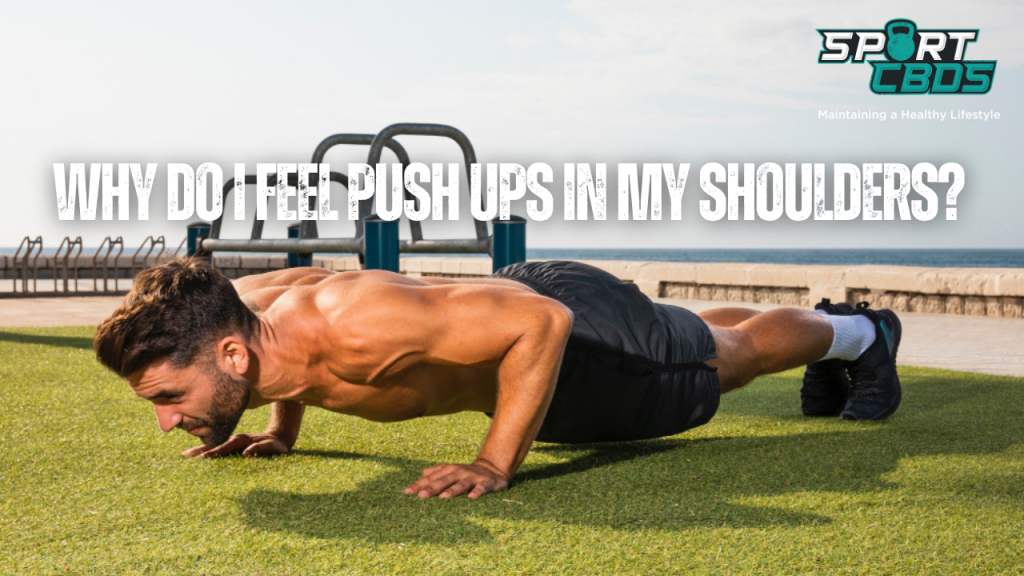
Why Do I Feel Push Ups In My Shoulders? 11 Factors To Consider
Push-ups are a timeless exercise targeting the chest, triceps, and shoulders. However, improper execution may result in discomfort or even pain in the shoulders.
In this article, we’ll delve into common errors leading to shoulder discomfort during push-ups, how to rectify them, factors causing shoulder discomfort, and the significance of proper form and technique.
Why Do I Feel Push Ups In My Shoulders?
The sensation of feeling push-ups in the shoulders can be attributed to various factors, including improper form, muscular imbalances, and previous injuries. When performing push-ups, incorrect body alignment, flared elbows, inadequate hand placement, or insufficient core engagement can place excessive stress on the shoulder joints, leading to discomfort. Additionally, an unbalanced workout routine that neglects opposing muscle groups, such as the back muscles, may contribute to instability and strain in the shoulder area. Overuse injuries caused by excessive push-up volume or frequency can exacerbate shoulder discomfort. Furthermore, past shoulder injuries like rotator cuff tears, impingement, or dislocations can make individuals more prone to discomfort while performing push-ups. Other factors include an uneven press, limited range of motion, and referred pain from tight chest muscles or poor thoracic spine mobility. Addressing these issues through proper form, balanced training, and targeted stretching and mobility exercises can help alleviate shoulder discomfort during push-ups.
Misaligned Body Posture (Body is too vertical)
One typical error during push-ups is positioning the body too vertically, causing excessive stress on the shoulder joints. Picture doing a push-up with your feet against a wall and hands close to the wall; this position puts immense pressure on the shoulders. To rectify this, keep a straight line from your head to your heels, engage your core, and maintain a neutral head position.
For instance, visualise your body as a wooden plank that must retain its shape throughout the exercise. This analogy assists in understanding the necessity of proper body alignment during push-ups.
Inadequate Shoulder Blade Management (Lack of shoulder blade control)
Another frequent mistake is failing to control the shoulder blades during push-ups, resulting in instability and discomfort. When executing a push-up, focus on stabilising and retracting (squeezing together) your shoulder blades as you descend. This maintains a stable shoulder joint and safeguards the rotator cuff muscles.
A useful suggestion is to envision clenching a pencil between your shoulder blades as you carry out the push-up. This reminder aids in ensuring appropriate shoulder blade control and minimises the risk of injury.
Elbows Flaring Out (Elbows excessively flared)
Allowing your elbows to flare out during push-ups adds unwarranted stress on the shoulder joint and heightens the likelihood of injury. Instead, keep your elbows close to your body, forming approximately a 45-degree angle between your torso and upper arms.
Visualise your arms as arrows pointing forward while performing push-ups. This mental image can help you maintain proper elbow positioning and minimise shoulder strain.
Inappropriate Hand Positioning (Hand placement is off)
Improper hand positioning is another factor that can cause shoulder discomfort during push-ups. Positioning your hands too wide strains your shoulders, whereas placing them too high or low leads to incorrect body alignment. Ideally, hands should be slightly wider than shoulder-width apart, with fingers facing forward and wrists aligned beneath your shoulders.
Consider your hands as the base of a building. A robust foundation guarantees the stability and structural integrity of the entire construction, much like proper hand positioning supports your body during push-ups.

Inadequate Body Support (Failing to brace your body)
Neglecting to engage your core and maintain tension throughout your body results in instability and additional stress on your shoulders during push-ups. To effectively brace your body, tighten your abdominal and gluteal muscles while keeping a neutral spine.
Envision your body as a bridge: if the support beams (your core and glutes) aren’t sturdy, the bridge will give way. This imagery can help reinforce the importance of supporting your body during push-ups.
There are several factors leading to shoulder discomfort, resolving these issues can have a massive effect on how much you feel this exercise in the shoulder area.
Unbalanced Workout Routine
An unbalanced workout routine may be responsible for shoulder discomfort during push-ups. If you overemphasise chest and shoulder exercises while overlooking your back muscles, this can create muscle imbalances and instability in the shoulder joint. Include exercises targeting your back muscles, such as rows and pull-ups, to maintain an even muscle development.
It’s very important to have a well rounded fitness program, as this will give you the best possible chance of reducing any muscular imbalances you may experience only ever doing the same few exercises.
Related: Why Do I Feel My Armpit More the Day After Chest Workout?
Overuse and Muscular Imbalances
Excessive frequency or volume of push-ups might result in overuse injuries and muscular imbalances. Over time, this may lead to shoulder discomfort and strain. To avoid these issues, refrain from doing push-ups daily, and ensure your training routine includes sufficient rest and recovery time.
It’s crucial to maintain workout balance by including exercises that work on opposing muscles, like rows for your back.
Prior Injuries
Previous shoulder injuries might make you more prone to experiencing discomfort during push-ups. Issues such as rotator cuff tears, shoulder impingement, or dislocations can have lingering effects on your push-up performance. If you have a history of shoulder injuries, seek advice from a healthcare professional or a certified personal trainer for guidance on safely executing push-ups and other exercises.
Unbalanced Press
An unbalanced press in push-ups can exert more stress on one shoulder, causing discomfort and potentially leading to injury. To prevent this, concentrate on applying even pressure through both hands and engaging your core muscles for body stabilisation. Practicing push-ups on an unstable surface like a BOSU ball or suspension straps can enhance your balance and stability.
Restricted Range of Motion (Insufficient ROM)
A limited range of motion might lead to shoulder discomfort during push-ups. Tight shoulders with reduced mobility can make it difficult to execute push-ups correctly and safely. Integrate shoulder stretches and mobility exercises into your routine to enhance your range of motion and alleviate discomfort during push-ups.
Discomfort Originating from Other Regions (Could it be from another area?)
Occasionally, shoulder discomfort during push-ups may stem from problems in other parts of your body. Tight chest muscles or inadequate thoracic spine mobility, for instance, can contribute to shoulder pain. Include stretching and mobility exercises that target these areas to tackle any potential issues that might be causing your discomfort.
Push Up Workout
This workout routine can be performed 2-3 times a week, ensuring you have at least one rest day between sessions to allow your muscles to recover. As you progress, you can gradually increase the number of sets and reps or try more advanced variations to challenge yourself. Remember to listen to your body and modify the exercises as needed to avoid discomfort or injury.
Warm-up:
- Jumping jacks: 2 sets of 30 seconds
- Arm circles: 2 sets of 30 seconds (15 seconds forward, 15 seconds backward)
- Shoulder rolls: 2 sets of 10 reps (5 reps forward, 5 reps backward)
- Cat-cow stretch: 2 sets of 10 reps
Push-up Workout:
- Standard push-ups: 3 sets of 10-15 reps
- Wide push-ups: 3 sets of 10-12 reps
- Diamond push-ups: 3 sets of 8-10 reps
- Incline push-ups: 3 sets of 10-15 reps
- Decline push-ups: 3 sets of 10-12 reps
- Staggered push-ups: 3 sets of 8-10 reps per side
Perform each exercise with proper form and technique, resting for 30-60 seconds between sets. If you find the standard push-up too challenging, feel free to modify the exercises by performing them on your knees.
Cool-down:
- Child’s pose: Hold for 30-60 seconds
- Chest stretch: Hold for 30 seconds per side
- Doorway stretch: Hold for 30 seconds per side
- Triceps stretch: Hold for 30 seconds per side
Related: Why Don’t I Feel a Pump in My Chest?
FAQs
Where should you feel it when doing pushups?
When performing pushups, you should primarily feel the exercise targeting your chest (pectoral) muscles, as well as your triceps and shoulders (deltoids). Proper form and technique will ensure the right muscles are engaged during the movement.
How to do a pushup without hurting your shoulders?
To prevent shoulder discomfort while doing pushups, focus on proper form, including maintaining a straight body alignment, keeping your elbows at a 45-degree angle to your body, positioning your hands slightly wider than shoulder-width apart, and engaging your core. Avoid flaring your elbows, placing excessive stress on your shoulder joints, and ensure you have balanced muscle development through a well-rounded workout routine.
Why don’t I feel my chest in push-ups
If you don’t feel your chest working during push-ups, it could be due to improper form or muscle imbalances. Ensure you are using correct technique, engaging your chest muscles, and maintaining a proper hand placement. Incorporating different push-up variations, such as wide push-ups, can also help target the chest muscles more effectively.
Why do I feel pushups in my shoulders and not my chest?
Feeling pushups primarily in your shoulders instead of your chest may indicate improper form or muscle imbalances. Ensure your body alignment is correct, your elbows are at the right angle, and your hands are placed appropriately. Additionally, focusing on engaging your chest muscles during the movement and including other chest-focused exercises in your routine can help improve muscle activation.
Will push-ups give me a nice chest?
Yes, push-ups can contribute to building a well-defined chest when performed consistently and with proper form. Push-ups target the chest muscles, triceps, and shoulders, helping to build strength and muscle definition. Including different push-up variations and other chest exercises, such as bench presses and chest flys, in your workout routine will further enhance your chest development.
Final Thoughts…
In conclusion, feeling push-ups in your shoulders can be the result of various factors such as improper form, muscle imbalances, overuse, previous injuries, and even referred pain from other areas. To alleviate shoulder discomfort and reduce the risk of injury, it’s essential to focus on maintaining proper form and technique, engaging your core, and ensuring balanced muscle development through a well-rounded workout routine.
By addressing issues like uneven press and limited range of motion, you can improve your push-up performance and promote overall shoulder health. Don’t hesitate to seek advice from a healthcare professional or a certified personal trainer if you have a history of shoulder injuries or persistent discomfort.
Incorporating these insights into your push-up practice can help you build strength safely and effectively, while minimising the strain on your shoulders.
Do you feel push ups more in your shoulders and have these tips helped? Let me know in the comments below.
If you enjoy sport and use CBD to help with your recovery in between gruelling workouts, then you are in the right place. Here at Sport CBDs, we train hard and recover the best way possible…
We have regular workouts (check out the YouTube channel), CBD news and CBD products to help you gain that edge!
If you wanted to check out the reputable CBD we have on offer here at the site, then please head to the Sport CBDs Store (CLICK HERE). We also do fitness clothing and yoga accessories too.
Until next time, all the best…

Lee
Founder – Sport CBDs
Featured Image Attribution – Image by Freepik

